Nestled in the heart of Java, Indonesia, lies Yogyakarta, a city renowned for its cultural heritage and delectable cuisine. Among its most iconic dishes is Gudeg Yogya, a sweet and savory jackfruit stew that has captured the hearts of food enthusiasts worldwide. Known for its unique taste and traditional preparation methods, Gudeg Yogya isn’t just a meal—it’s a cultural experience that tells the story of Javanese tradition, history, and philosophy.
For many Indonesians, Gudeg Yogya is more than just food; it’s a taste of home. The dish has been passed down through generations, and each bite carries the warmth of tradition and the richness of history. Its sweet flavor, derived from palm sugar and coconut milk, sets it apart from most other Indonesian dishes, which are typically savory or spicy. This distinctive taste makes Gudeg Yogya a niche food—beloved by many, yet a surprise to those unfamiliar with the concept of a sweet main course.
Table of Contents
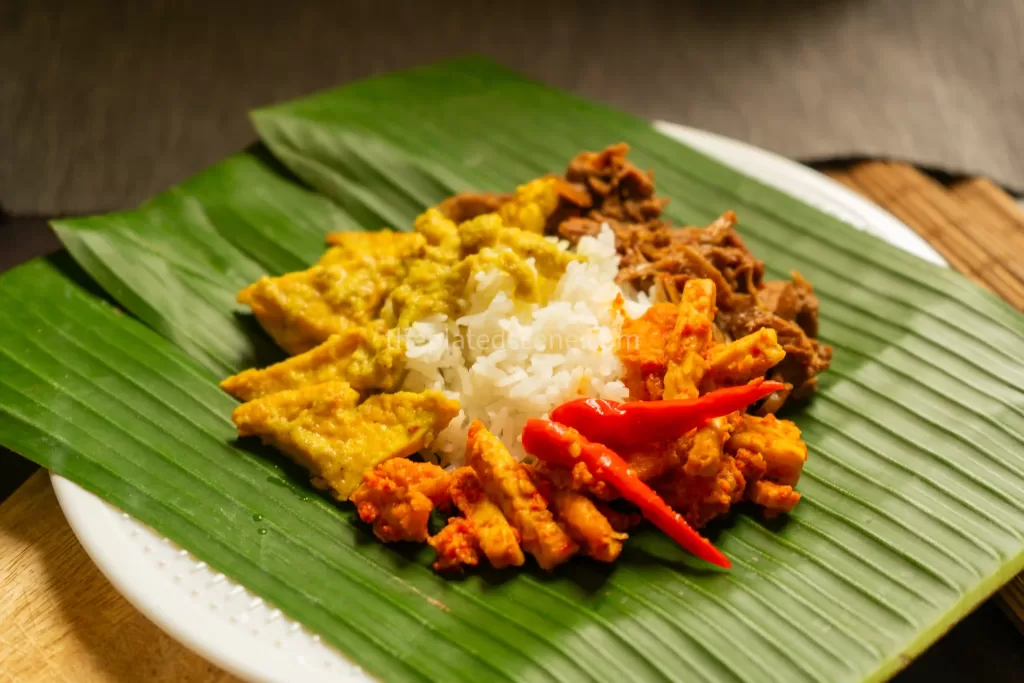
The Essence of Gudeg Yogya
What makes Gudeg Yogya so unique? It’s the perfect blend of flavors, the meticulous cooking process, and the cultural significance that elevate it beyond ordinary cuisine. At its core, Gudeg Yogya is a slow-cooked stew made from young jackfruit, locally known as gori. The jackfruit is simmered for hours in a mixture of coconut milk, palm sugar, and traditional spices, melding the flavors into a harmonious symphony of sweet and savory.
The dish’s unique flavor profile is complemented by its rich history. In Yogyakarta, Gudeg Yogya has become a symbol of the region’s culinary identity. It’s often said that no visit to Yogyakarta is complete without sampling this iconic dish. Gudeg Yogya is a source of pride for locals—representing their heritage and culinary artistry.
A Niche Dish for Discerning Palates
Despite its widespread appeal in Indonesia, Gudeg Yogya remains a niche dish. Its sweet flavor can be polarizing, especially for those who associate sweetness exclusively with desserts. While some may find the idea of a sweet main course unusual, others embrace it as a delightful departure from the norm. Gudeg Yogya’s distinctive taste makes it a dish that people adore or struggle to appreciate.
For those who love Gudeg Yogya, the dish becomes an obsession. Its unique blend of sweetness and traditional spices creates a comforting and exotic flavor profile. It’s no wonder that Gudeg Yogya has developed a loyal following among food lovers, both in Indonesia and beyond Western “fast food,” Gudeg is the perfect example of Javanese slow and thorough cooking.
The Origins of Gudeg Yogya
The story of Gudeg Yogya dates back to the 16th century during the rise of the Mataram Kingdom in Java. As the kingdom’s soldiers began clearing forests to establish a new civilization, they discovered an abundance of jackfruit and coconut trees. Faced with the challenge of feeding large numbers of soldiers, they began cooking young jackfruit and coconut together in massive cauldrons. The dish was stirred continuously using large paddles made from mahogany, a process known as hangudek in Javanese. Over time, this term evolved into “Gudeg,” the name the dish is known today.
Gudeg Yogya’s origins reflect the resourcefulness and creativity of the Javanese people. They created a culinary masterpiece that has stood the test of time by transforming simple, readily available ingredients into a flavorful and nourishing dish. Today, Gudeg Yogya remains a staple of Javanese cuisine, symbolizing the region’s rich cultural heritage.
Philosophy Behind Gudeg Yogya
Beyond its delicious taste, Gudeg Yogya embodies the values and philosophy of Javanese culture. The process of making Gudeg requires patience, meticulousness, and calmness—qualities that are deeply ingrained in Javanese life. Unlike the fast-paced world of modern cooking, Gudeg Yogya is a slow-cooked dish that takes hours to prepare. Each step of the process, from blending the spices to simmering the jackfruit, is a labor of love that reflects the Javanese appreciation for thoroughness and attention to detail.
The patience required to make Gudeg Yogya mirrors the Javanese approach to life. In a world that often prioritizes speed and efficiency, the art of preparing Gudeg Yogya serves as a reminder to slow down and savor the process. It celebrates tradition, mindfulness, and the joy of creating something truly special.
Varieties of Gudeg
One of the fascinating aspects of Gudeg Yogya is its versatility. While the dish originated in Yogyakarta, it has inspired several regional variations, each with its unique characteristics:
- Gudeg Yogya: This version is known for its dry texture and deep, dark color. Using teak leaves (daun jati) as a natural coloring agent gives the dish its signature reddish-brown hue. Gudeg Yogya is often called “red gudeg” and is less saucy than other versions.
- Gudeg Solo: Originating from Solo (Surakarta), this version is more watery and lighter in color. It’s often called “white gudeg” due to the absence of teak leaves. The higher coconut milk content gives Gudeg Solo a creamier and more soup-like consistency.
- Gudeg Jawa Timur: In East Java, Gudeg takes on a spicier and bolder flavor profile. This version is a favorite among those who prefer food with a bit of heat.
While each variation has its charm, Gudeg Yogya remains the dish’s most iconic and widely recognized version. Its rich flavor and cultural significance make it a must-try for anyone visiting Yogyakarta.
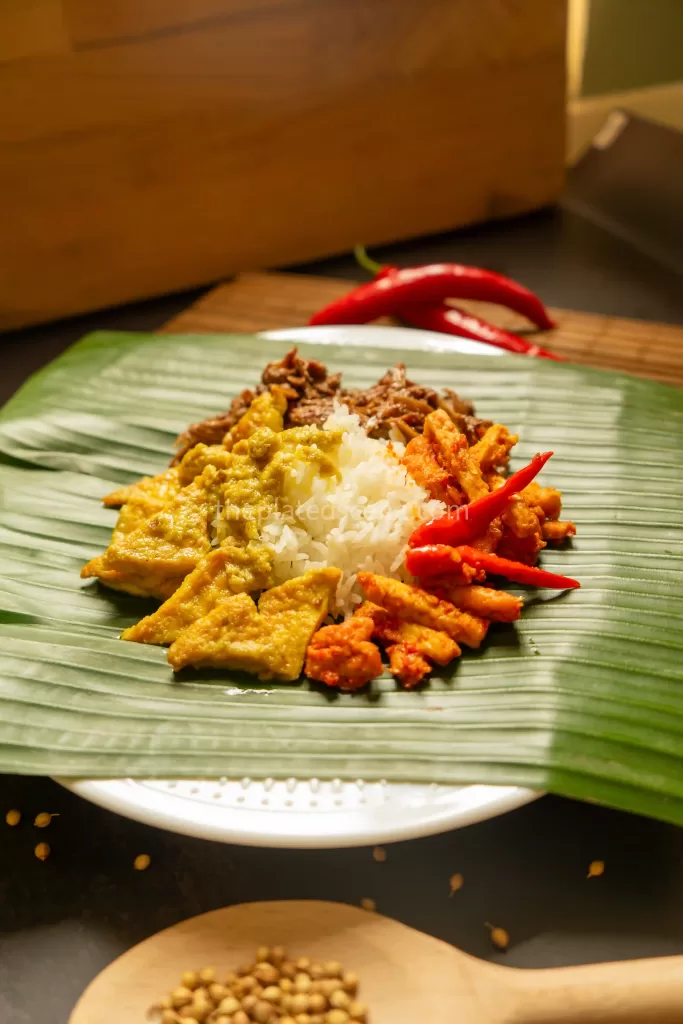
How to Enjoy Gudeg Yogya
To fully appreciate Gudeg Yogya, pairing it with the right accompaniments is essential. Traditionally, the dish is served with steamed rice and a variety of side dishes, including:
- Sambel Goreng Krecek: Spicy fried beef skin with chili and peanuts
- Opor Ayam: Coconut milk-braised chicken
- Telur Pindang: Seasoned boiled eggs
For a vegan twist, these side dishes can be replaced with plant-based alternatives such as:
- Terik Tahu: Coconut milk-braised tofu
- Sambel Goreng Tempe: Spicy fried tempeh with chili
Combining Gudeg Yogya with these accompaniments creates a balanced meal, highlighting the dish’s sweet and savory flavors.
Why You Should Try Gudeg Yogya
If you’ve never tasted Gudeg Yogya, you’re missing out on a unique culinary experience. Its sweet and savory flavors and rich cultural history make it a dish like no other. Whether you’re a seasoned foodie or someone looking to explore new cuisines, Gudeg Yogya offers a taste of comforting and exciting traditions.
For vegans and vegetarians, Gudeg Yogya is a particularly appealing option. Made from young jackfruit, the dish is a whole-food plant-based delight that’s both nutritious and satisfying. Its slow-cooked preparation ensures a depth of flavor that rivals even the most complex meat-based dishes.
The ingredients of Gudeg Yogya
Young Jackfruit / Gori
Young/unripe jackfruit has been getting a lot of love in recent times, particularly from the vegetarian/ vegan community, for its resemblance to pulled pork and the fact that it is a whole-food meat substitute rather than being fashioned out of wheat or soy.
Unripe jackfruit must be cooked before it can be eaten. It has a tough texture, needs a much longer cooking time than other vegetables, and is more similar to cooking meat. If you live outside Indonesia or Southeast Asia, it might be difficult to find fresh young jackfruit. If available, you can substitute the fresh jackfruit with canned young jackfruit (like this or this). I personally have never used this version of jackfruit but I assume as the canned jackfruit is already precooked and soft, the cooking time and the amount of water need to be reduced accordingly.
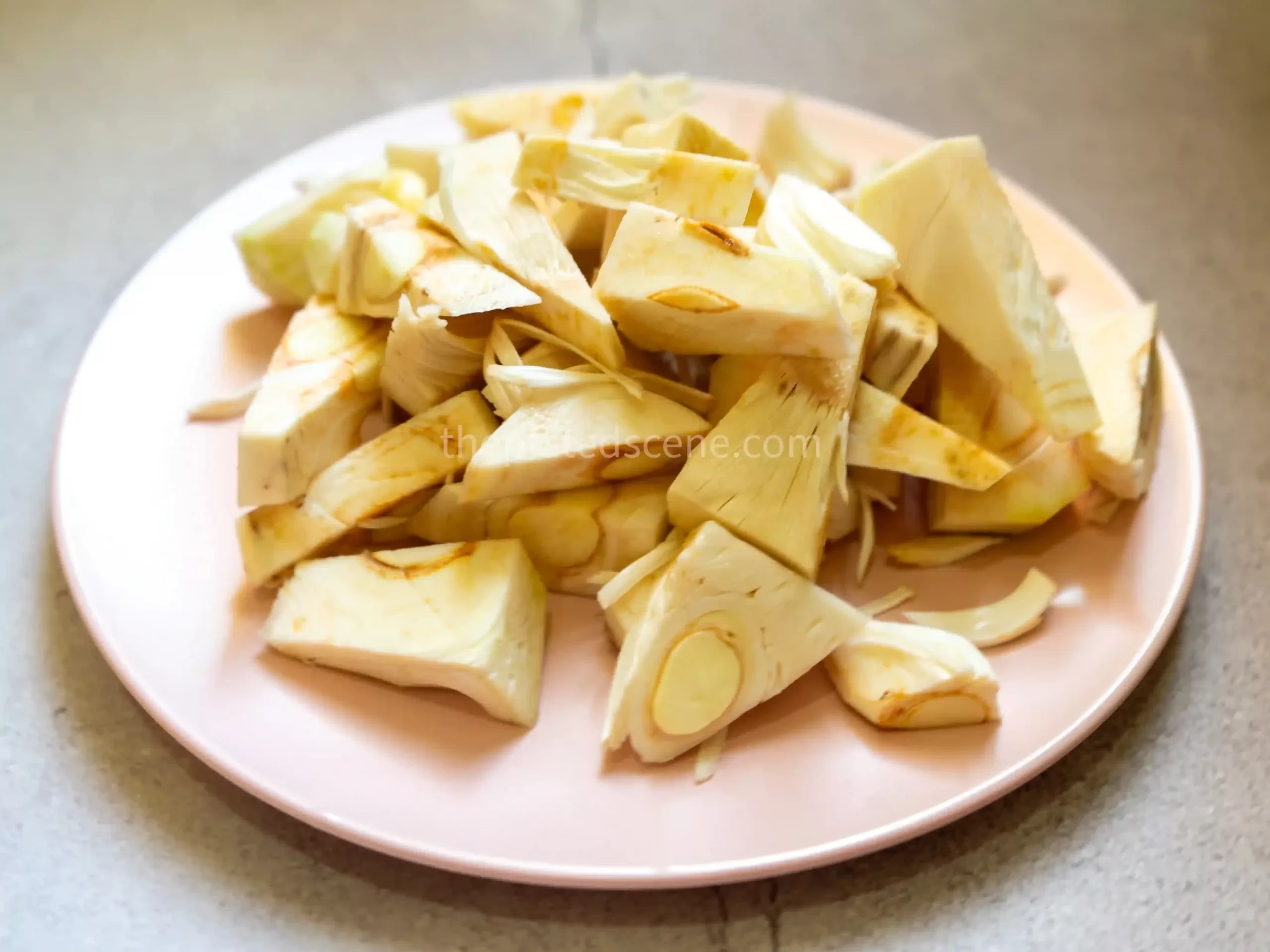
Blended Ingredients
- Shallots and garlic. If you read my other Indonesian food recipes in this blog, you will know we always include this dynamic duo. It’s pretty rare for Indonesian recipes to use one without the other. Garlic has a strong and pungent flavor, often used in savory dishes to add flavor and depth. Shallots have a milder flavor than garlic, with a hint of sweetness
- Coriander seeds. For this recipe, you can dry roast the fresh seeds to enhance the flavor, aroma, and pungency, but you don’t have to. However, I would avoid using ground or powdered seeds since they will lose flavor quickly. Coriander seeds, in general, will add a mild citrusy hint with a slight curry flavor. If you don’t have coriander in your kitchen staples, try substituting it with cumin
- Candlenut. Candlenuts’ high oil content contributes to the gravy’s thickness; therefore, they are added to gudeg Yogya to make this dish thicker, creamier, and slightly oilier. The presence of glutamic acid in candlenuts gives a dish a hint of nutty flavor. The mild bitterness in the candlenuts disappears upon cooking.
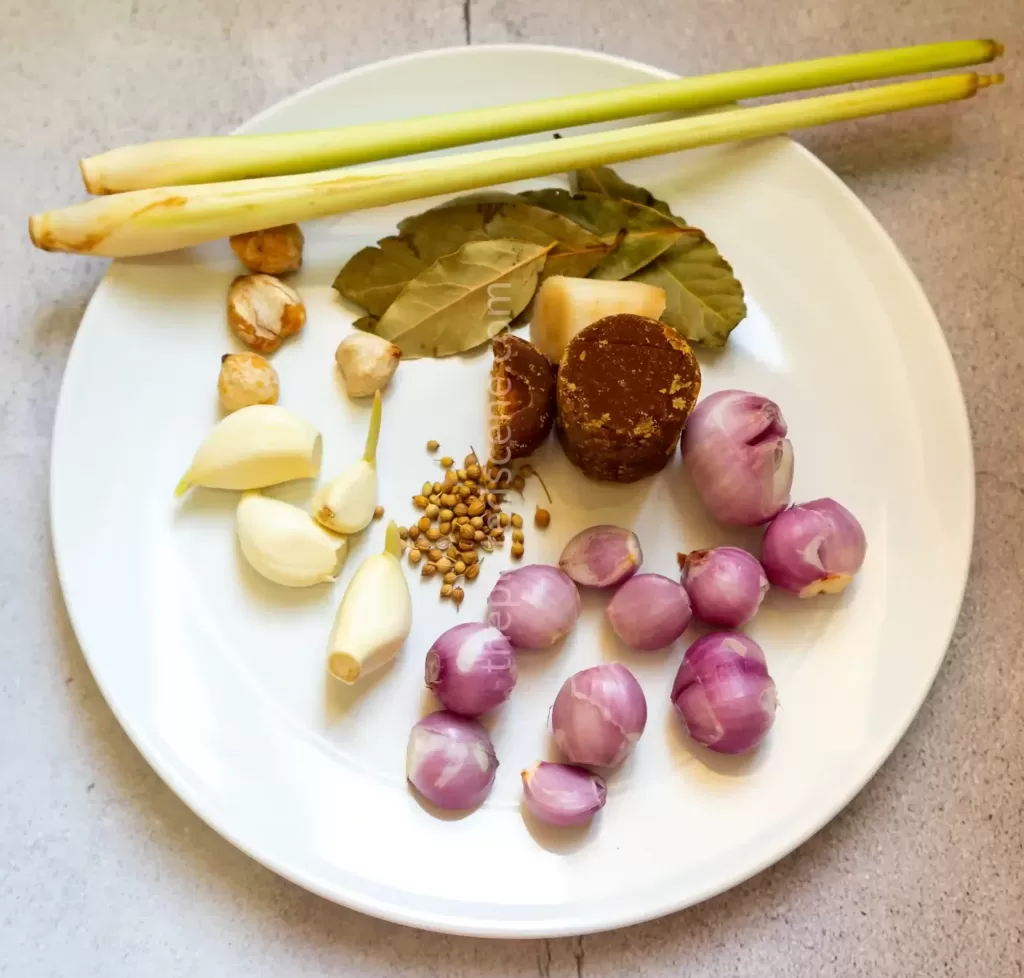
The liquids ingredients
- Tea. We use this tea in this recipe as a replacement for the teak leaves hence, we can assume the main purpose is to add color to gudeg. For this ingredient, try to use pure black tea without any other additional flavoring/ fragrance, such as jasmine.
- Coconut Milk. Coconut milk adds a rich, creamy texture to the gudeg, enhancing its overall mouthfeel. This creaminess helps balance the spices and flavors of the blended herbs. On top of that, coconut milk will act as a natural thickening agent, helping to give the gudeg its characteristic consistency and ensuring that the sauce clings to the ingredients. Yummy :).
Other Ingredients
- Palm sugar: This ingredient is important in this gudeg recipe. I mentioned at the beginning of this article that gudeg has a sweet and savory taste. I can say that the sweet taste is coming from no other than this palm sugar! Palm sugar usually comes in block size. So, you should shred it using a knife into smaller pieces to make it easy to dissolve.
- Galangal/ Blue Ginger. Galangal root is a relative of ginger and turmeric since they belong to the same family of plants. Despite belonging to the same family, there are significant differences in appearance, flavor, and texture between galangal and ginger. When young, galangal root is generally smoother and paler than ginger. Though galangal has a sharp taste, it is more citrusy, pine-like, and earthy, and some varieties have an almost minty, camphor-like scent and flavor. Ginger, on the other hand, is peppery with spicier notes. Galangal feels hard, woody, and fibrous, so cooks often discard it from dishes before serving.
- Bay Leaves. I often wonder whether bay leaves addition to the recipe makes a difference, so I googled and found this interesting article, “A Chef Settles the Debate: Do Bay Leaves Even Do Anything?”. So, if I can conclude based on my research, bay leaves infuse dishes with a woodsy flavor that also has subtle notes of eucalyptus and clove with the purpose of adding flavor and deepening existing flavor. Try not to omit it if you can!
- Lemongrass: To release more aromatic oil from lemongrass, I cut it in half and gently bruise the stalk to beat the surface. This helps break down its tough fibers.
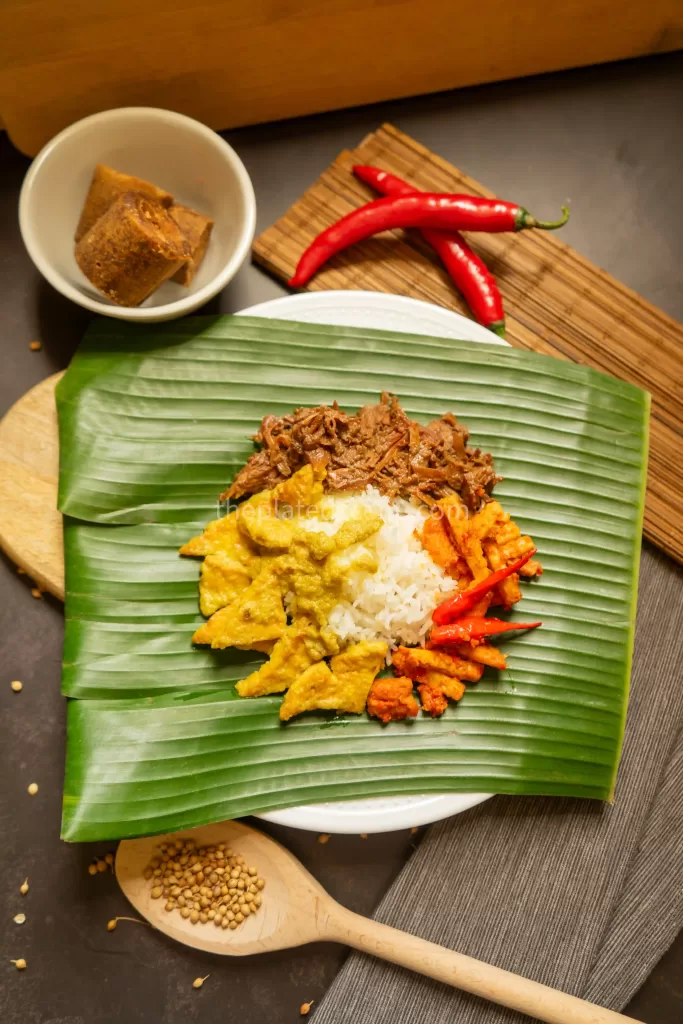
The Tools to Make Gudeg Yogya
There are 2 important tools that you need to have to make this Gudeg Yogya
- Blender. You can use any blender that will work to blend a small amount of Ingredients. This is because we are going to need it to blend some of the herbs. In this recipe, I am using Braun immersion blender (with its main blade). If you don’t have an immersion blender, don’t worry; you can use a regular blender or even a mortar and pestle.
- The slow cooker (pictured below) is really, really important. We are not going to cook the gudeg on the stove but using this slow cooker. If you don’t have one, don’t worry—they are easily available on Amazon. Here is the link for your reference.

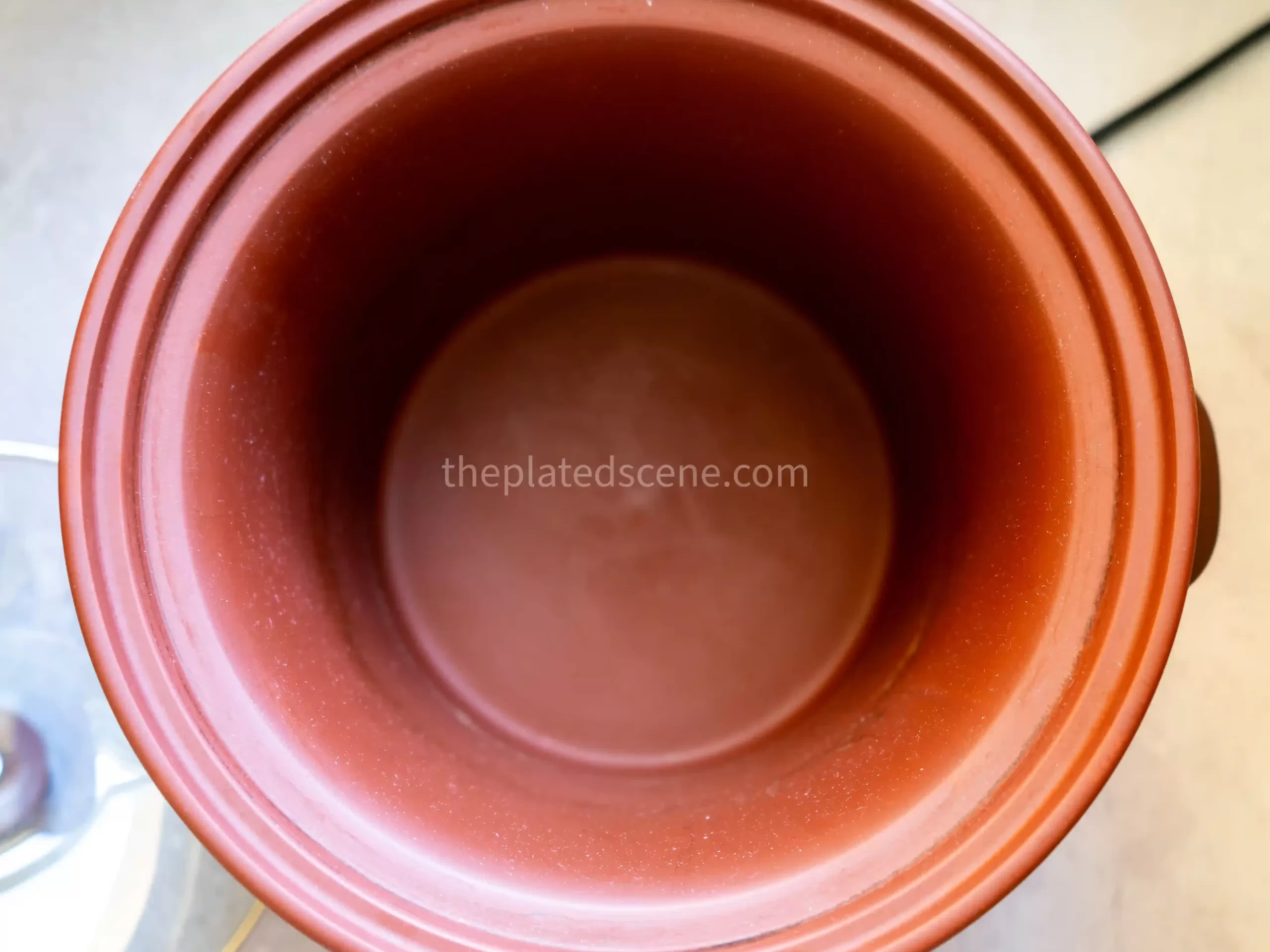
Step-by-Step to Make Gudeg Yogya
IMPORTANT NOTE: The cooking process for Gudeg Yogya will take roughly 9-12 hours. This long cooking time is essential to achieve the deep flavors and authentic texture that make this traditional dish from Yogyakarta so beloved.
Step 1: Prepare the Spice Blend (10-15 minutes)
The spice blend is the foundation of Gudeg Yogya. A well-prepared blend ensures the authentic taste and aroma of the dish.
- Toast the coriander seeds and candlenuts:
- Heat a dry pan over low heat. Add the coriander seeds and stir them constantly until they release a warm, nutty aroma. This process enhances their natural flavors.
- Next, toast the candlenuts in the same pan. Candlenuts must always be roasted or toasted before use, as they contain mild toxins that are neutralized through heat. Toast until they turn golden brown.
- Pro Tip: You can also sauté the candlenuts in a small amount of oil for a richer flavor.
- Blend the spices into a smooth paste:
- Combine garlic, shallots, toasted coriander seeds, and candlenuts in a blender or food processor. Blend until smooth. Add a small amount of water if needed to reach a paste-like consistency.
- Note: A traditional method involves grinding these spices with a mortar and pestle. While time-consuming, this method produces a more aromatic and textured paste.
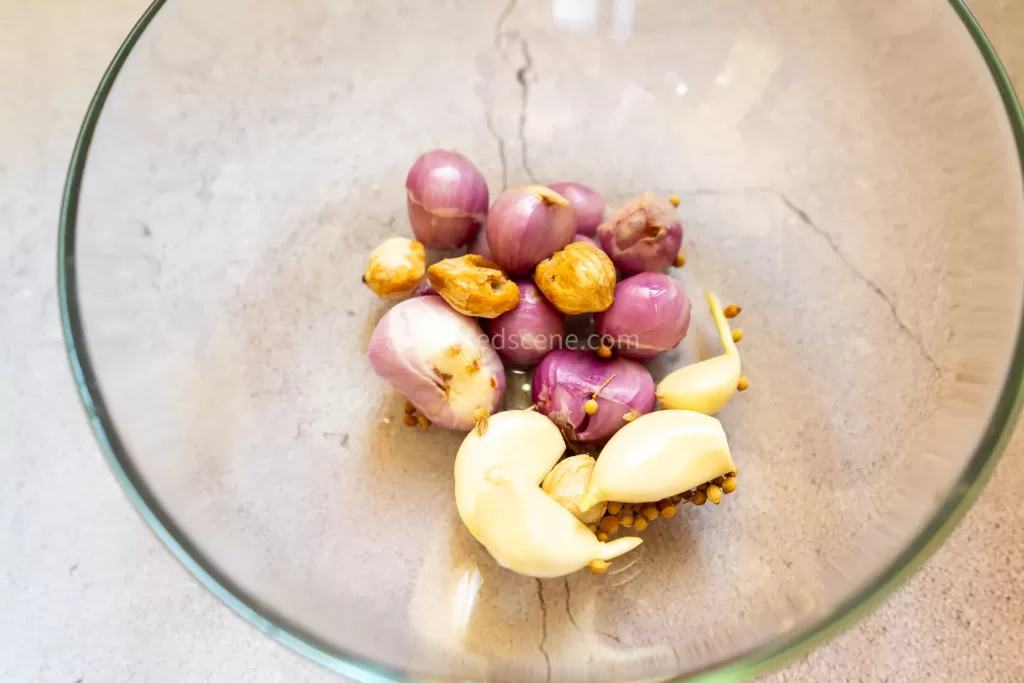
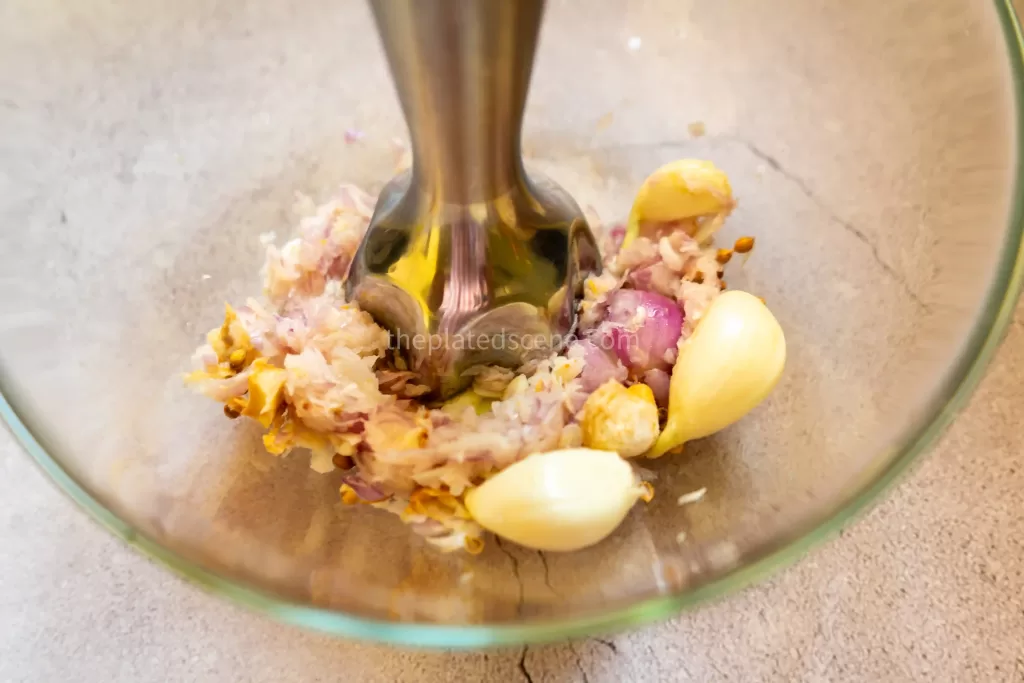
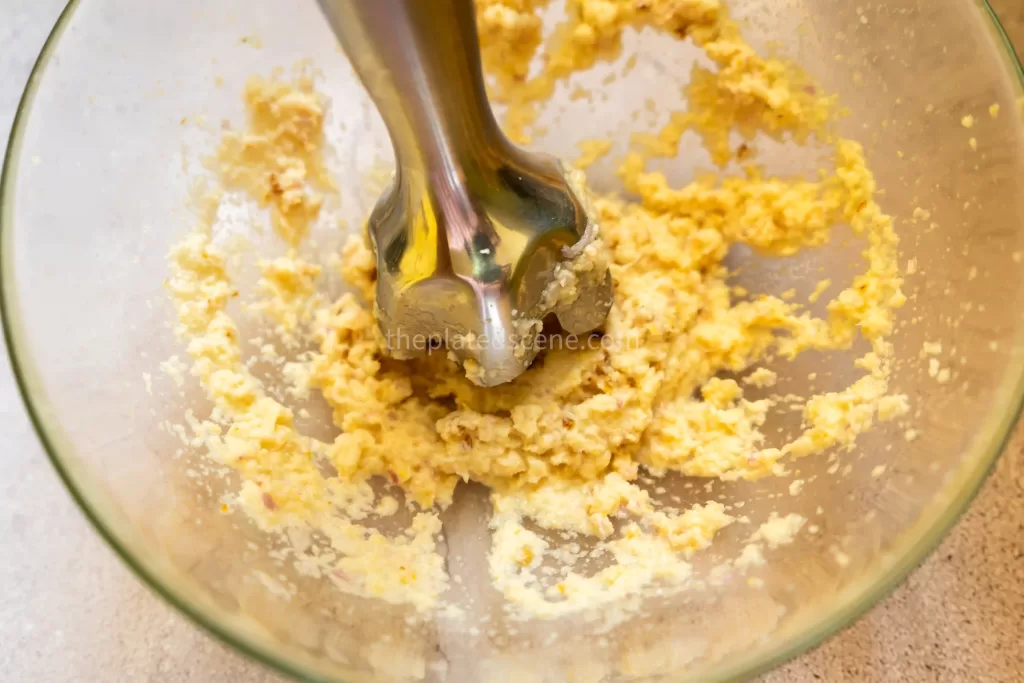
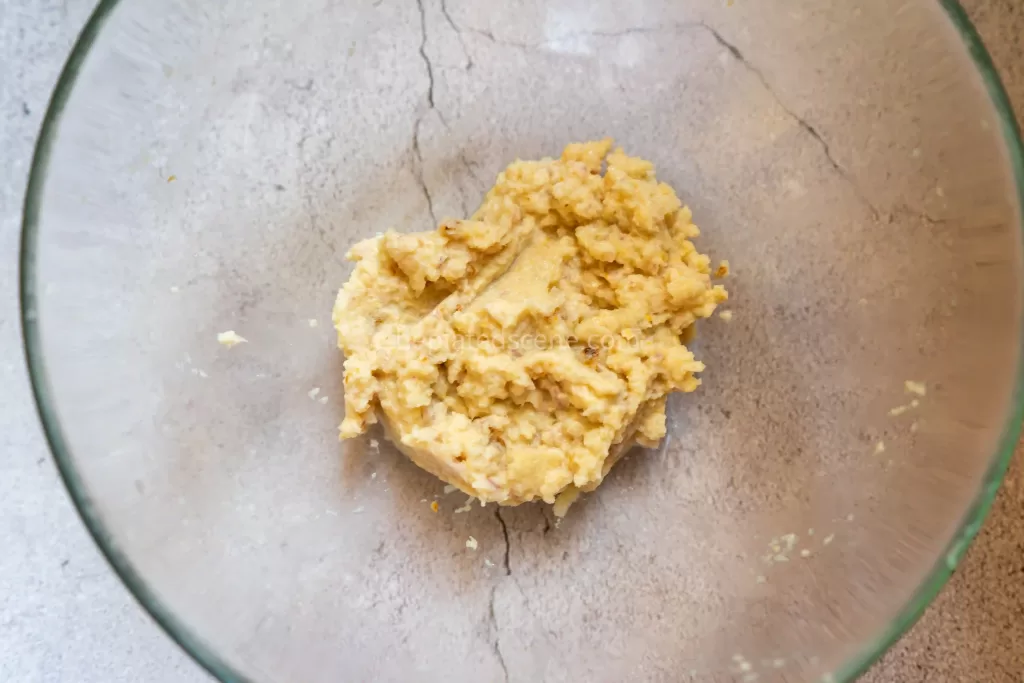
Step 2: Set Up the Slow Cooker Base (5 minutes)
- Layer the jackfruit:
- Place the unripe jackfruit pieces at the bottom of the slow cooker. Spread them out evenly to create a stable base.
- Why this matters: Even distribution ensures that the jackfruit cooks evenly and properly absorbs the spices and liquids.
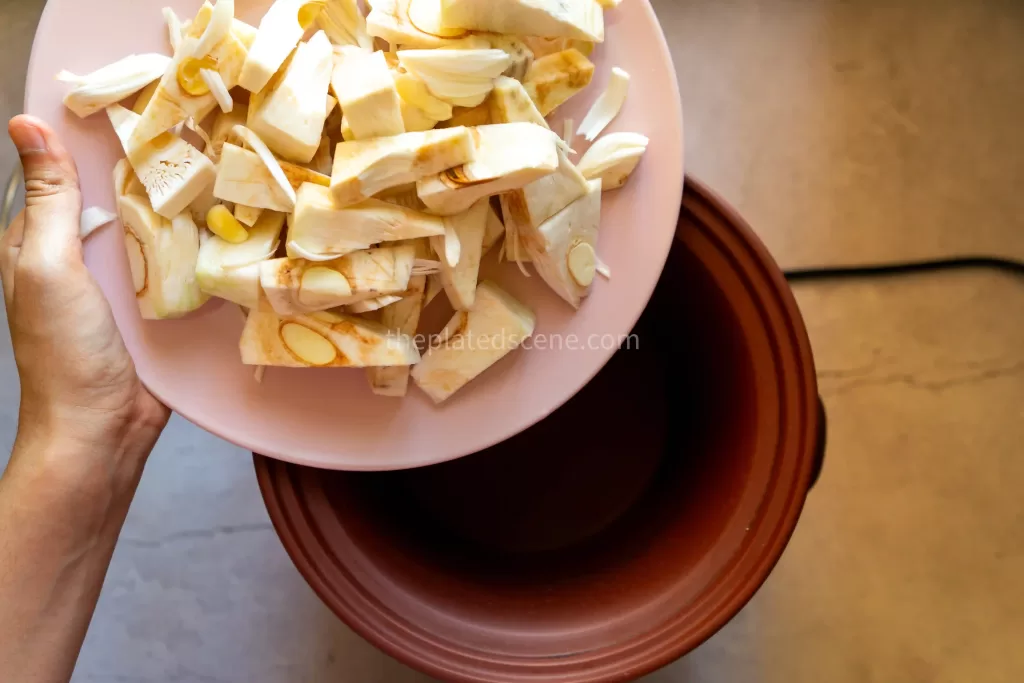
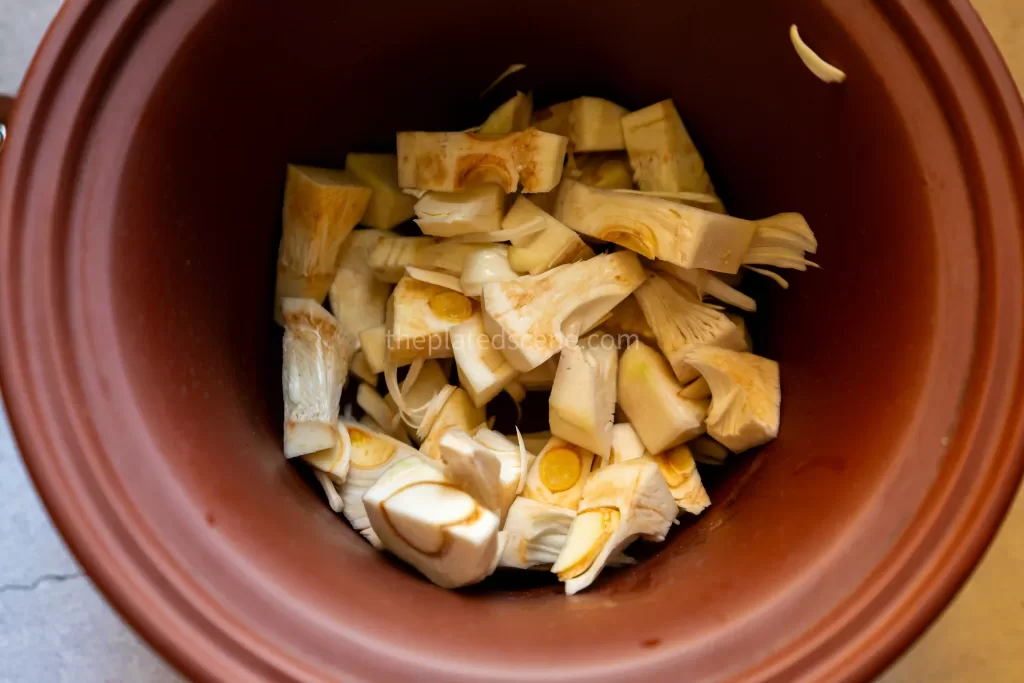
- Pour the liquids:
- Slowly pour brewed black tea and coconut milk over the jackfruit. Spread the liquids evenly to ensure every part of the jackfruit is coated.
- Black tea tip: The tea helps give Gudeg Yogya its signature brown color. Make sure the tea is brewed strong for the best results.
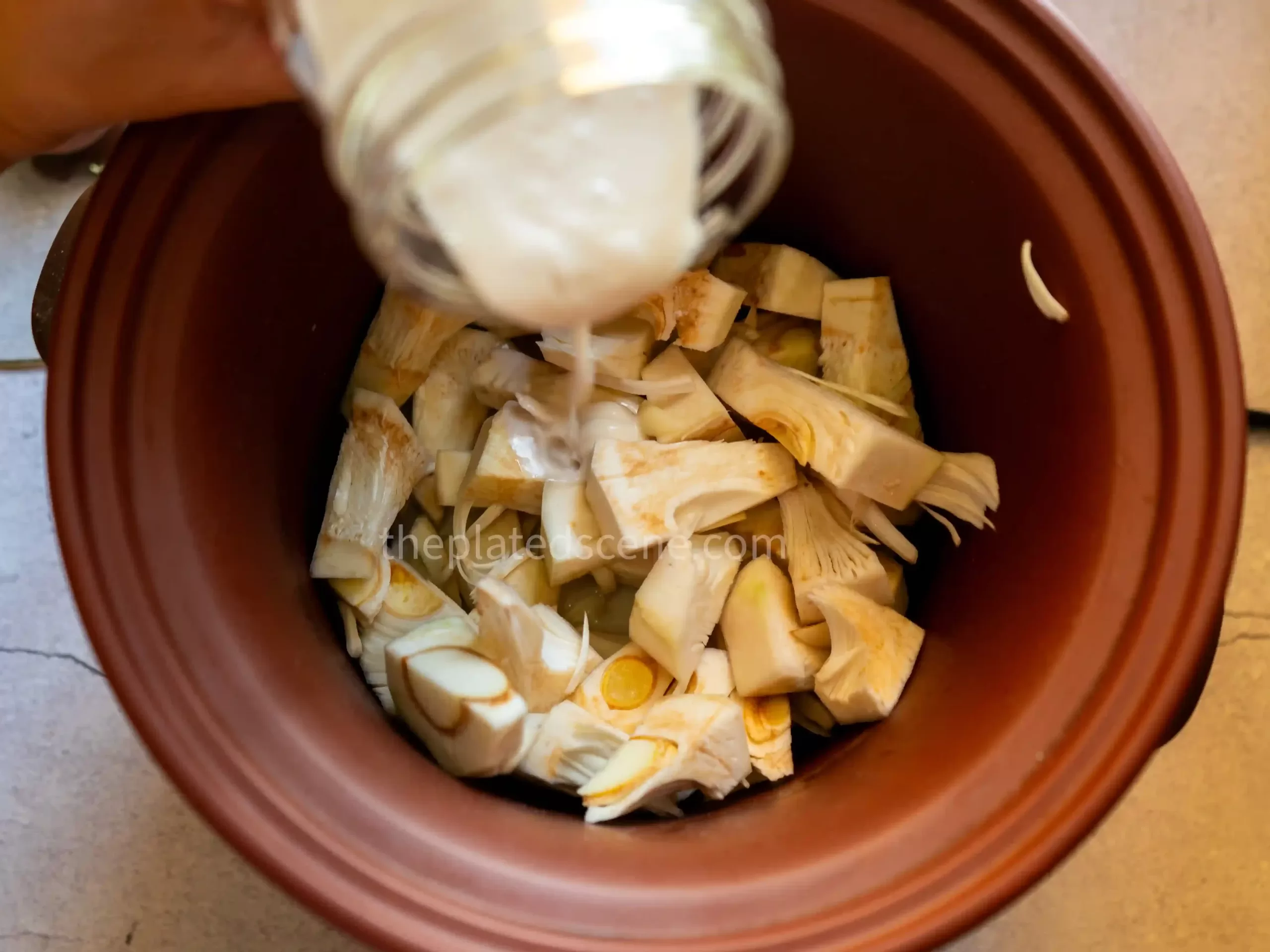
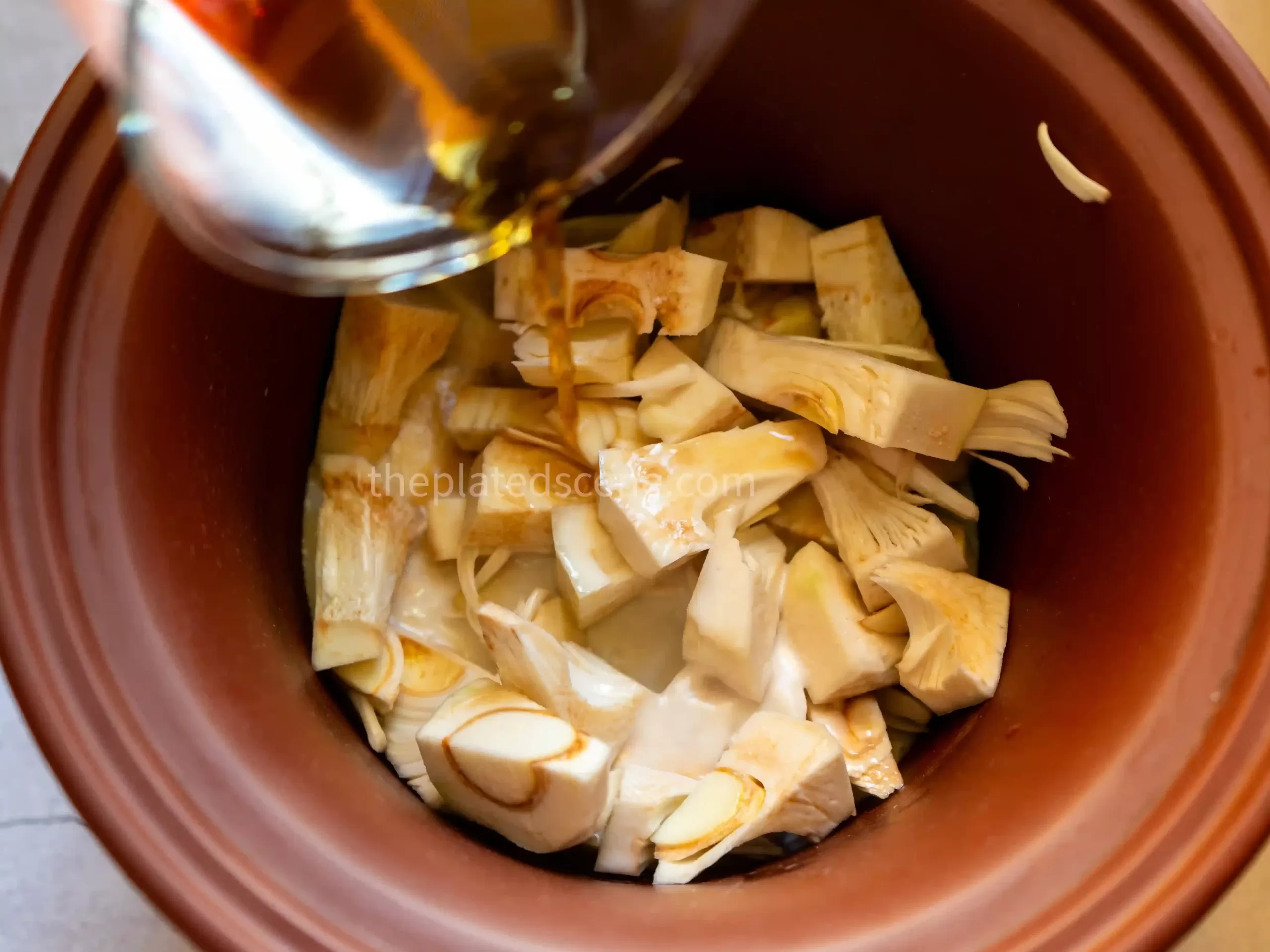
Step 3: Add the Spice Blend and Aromatics (10 minutes)
- Spread the spice blend:
- Carefully spoon the blended spice paste over the jackfruit. Spread it evenly, but do not stir.
- Why this matters: Allowing the spice paste to sit on top during the initial cooking phase helps the flavors infuse into the dish gradually.
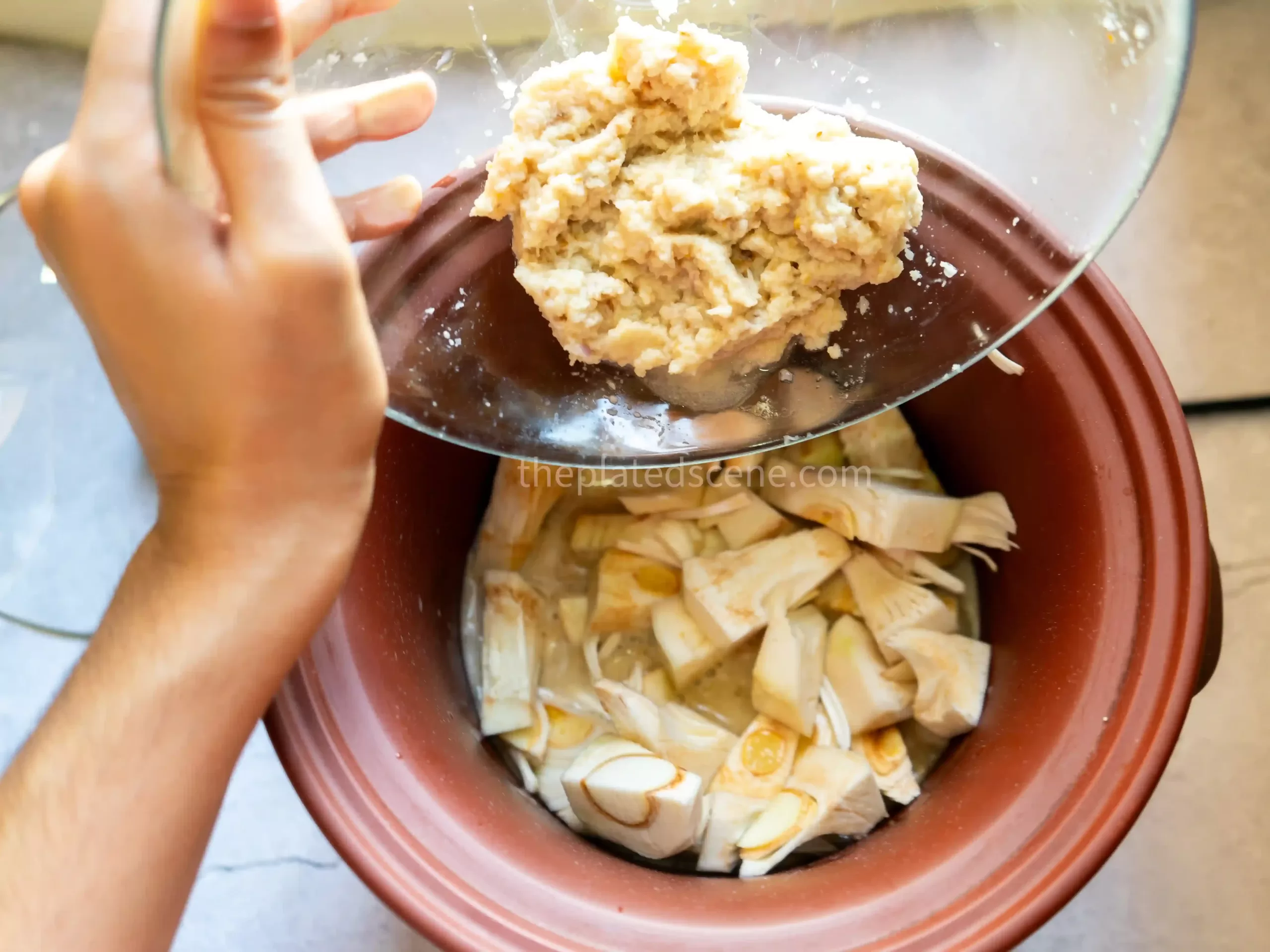
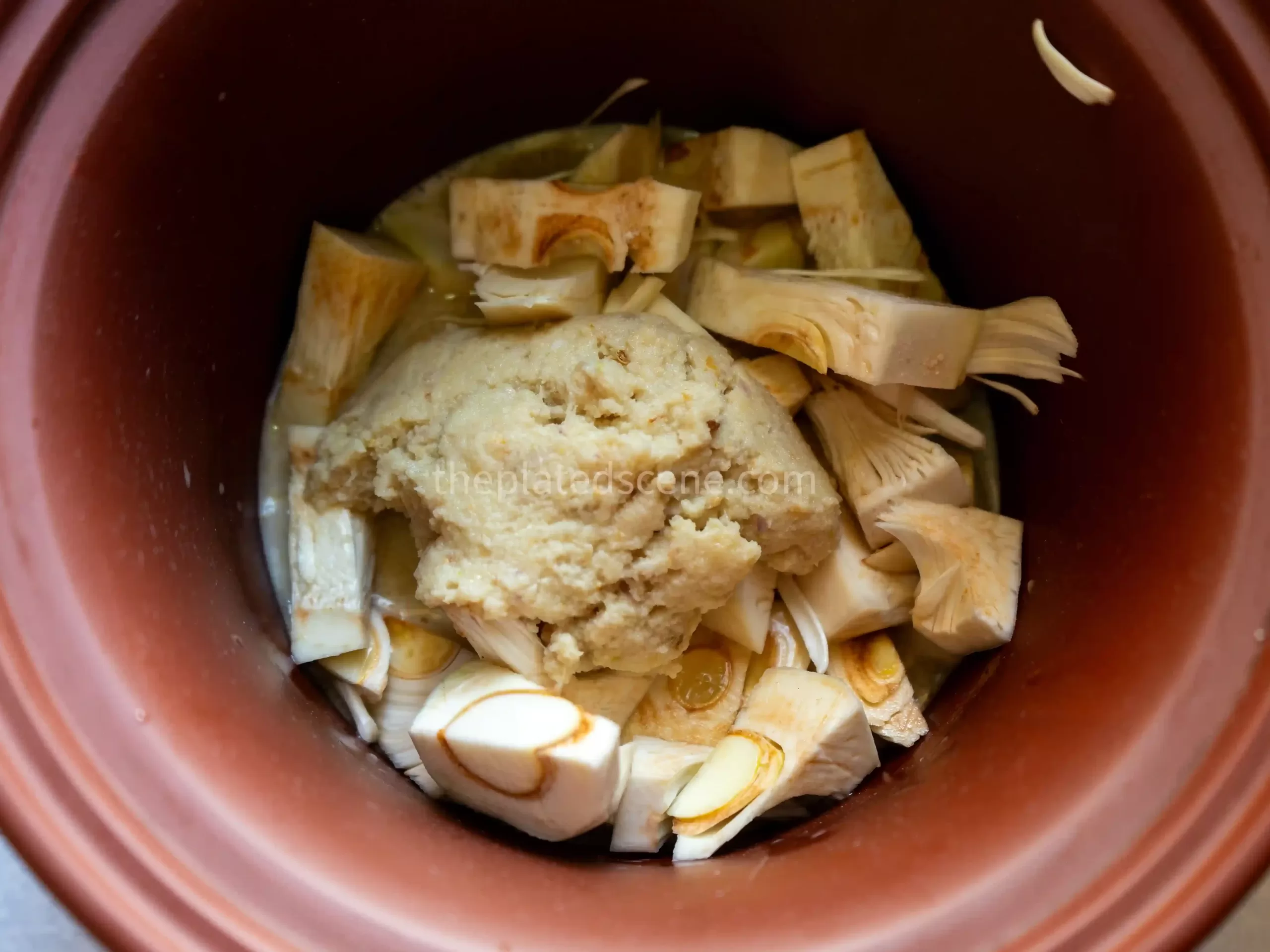
- Add the aromatics and sweetener:
- Add bay leaves, sliced galangal, and bruised lemongrass to the spice paste. Sprinkle grated palm sugar over the entire mixture.
- Pro Tip: Palm sugar is essential for the dish’s sweet taste. Grate it finely so it melts evenly during cooking.
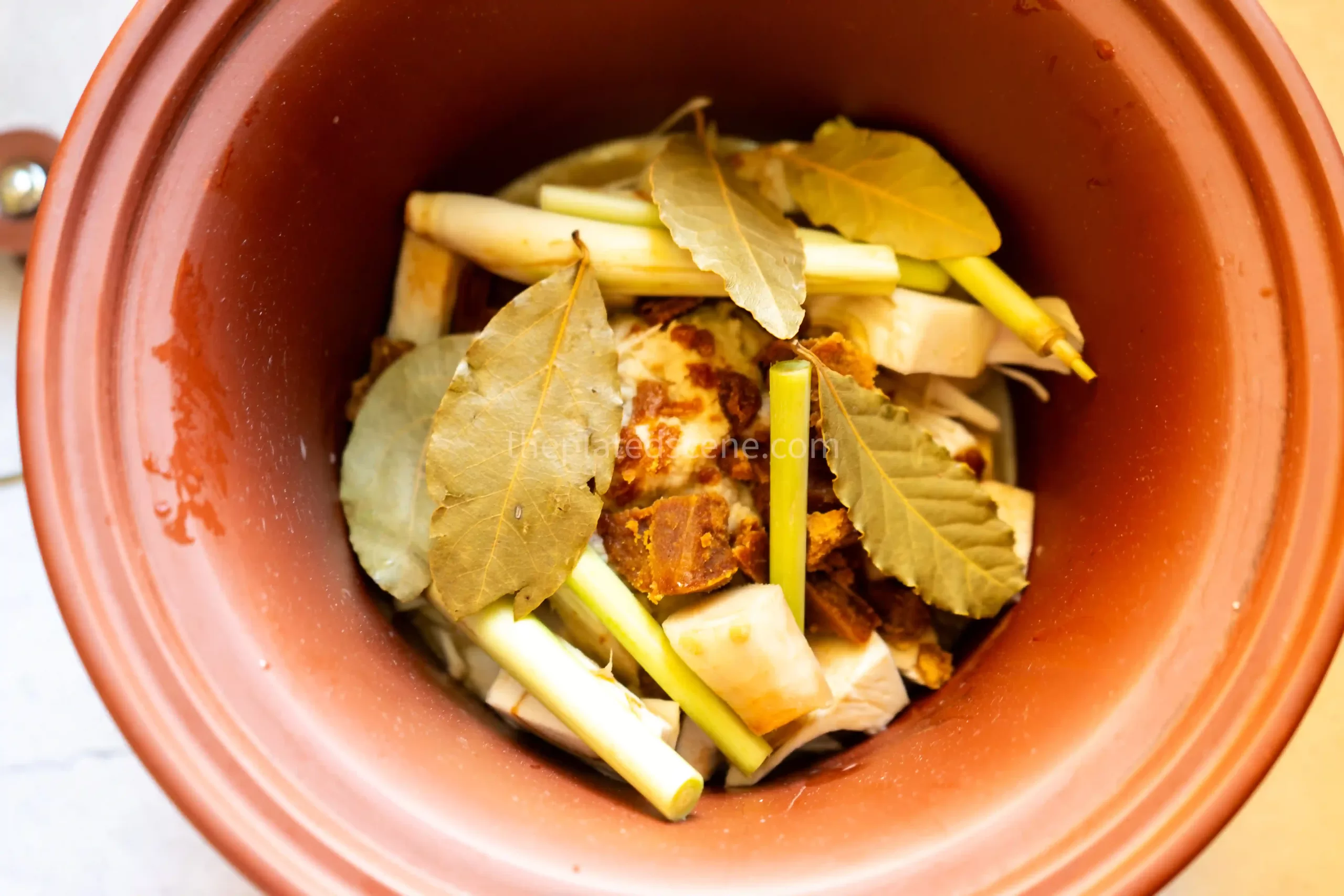
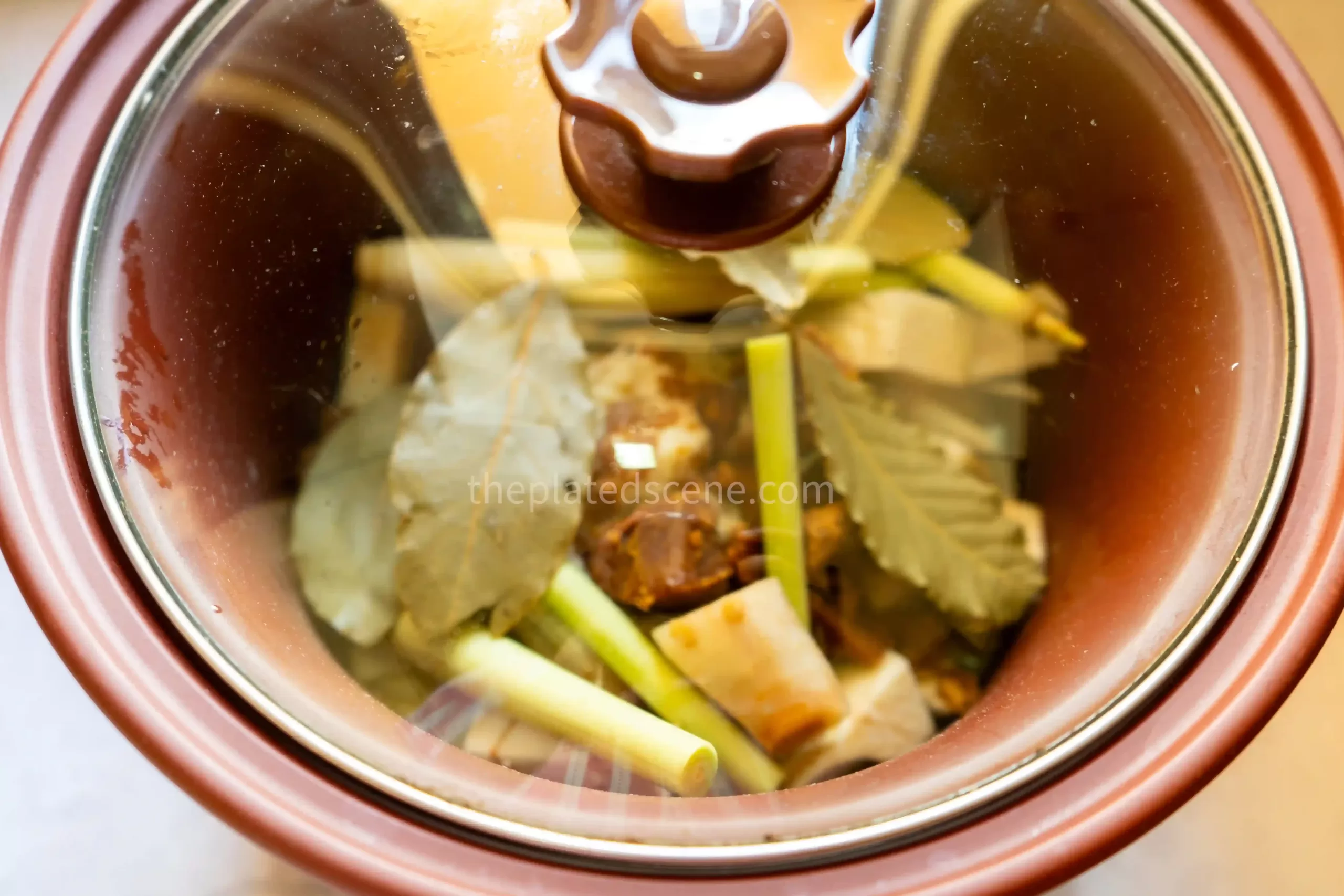
Step 4: Start the Slow Cooking Process (5-6 hours)
- Set the slow cooker to low heat:
- Cover the slow cooker and set it to the low heat setting. Let the Gudeg cook undisturbed for 5-6 hours.
- What happens during this time:
- The jackfruit absorbs the flavors from the spice paste and aromatics.
- The palm sugar and coconut milk caramelize slowly, giving the dish its rich brown color and sweet flavor.
Step 5: Stir and Continue Cooking (4-6 hours)
- Check the dish after 5-6 hours:
- Open the lid of the slow cooker. By now, the jackfruit should appear darker, and the liquid should have reduced slightly.
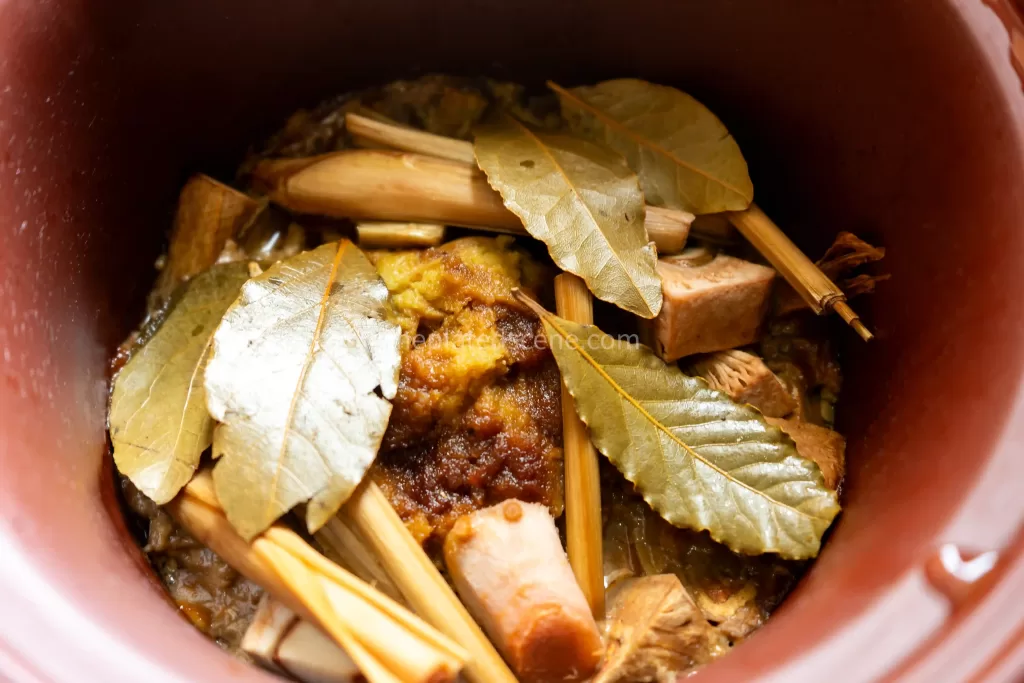
- Mix the ingredients thoroughly:
- Gently stir all the ingredients to distribute the spices, aromatics, and liquids evenly. This step allows every piece of jackfruit to soak up the rich flavors.
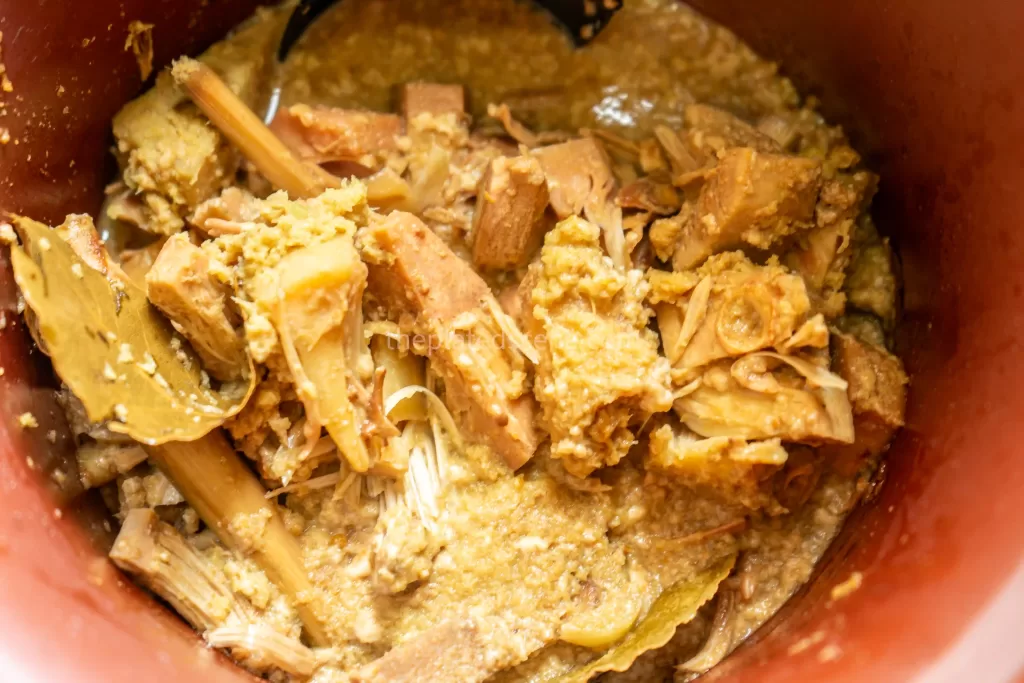
- Continue cooking:
- Cover the slow cooker again and let it cook for another 4-6 hours on low heat. During this time, the dish will develop its final texture and taste.
Step 6: Final Check and Serve (10 minutes)
- Check for doneness:
- After 9-12 hours of cooking, the Gudeg Yogya should have a deep brown color, a thick consistency, and a sweet, fragrant aroma. The jackfruit should be tender enough to break apart easily with a spoon.
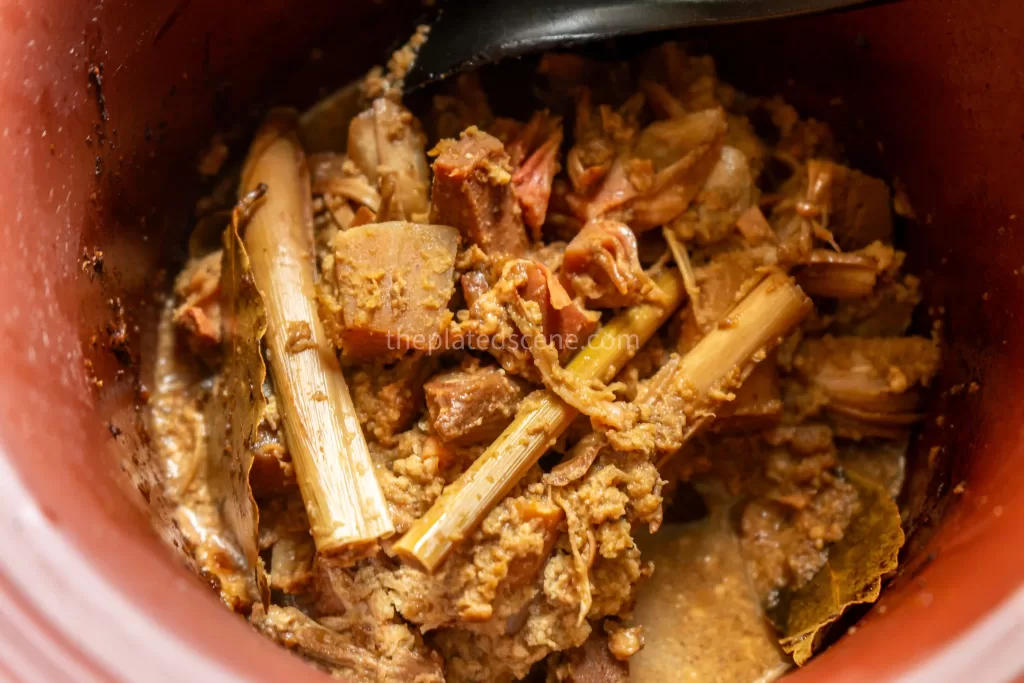
- Adjust seasoning (if necessary):
- Taste the Gudeg. Add a small pinch of salt or a touch of grated palm sugar to balance the flavors.
- Serve the dish:
- Spoon the Gudeg onto a plate of steamed rice. Garnish with hard-boiled eggs, fried chicken, or sambal krecek for an authentic Yogyakarta meal.
Tips for Perfect Gudeg Yogya
- Jackfruit selection: Use unripe jackfruit for the best results. It has a neutral flavor that absorbs spices beautifully and provides the signature texture of Gudeg.
- Slow cooking is key: The long cooking time allows the flavors to meld together and the jackfruit to soften to perfection.
- Don’t rush the process: Authentic Gudeg Yogya cannot be hurried. Plan to allow the full 9-12 hours for cooking.
Storing Gudeg Yogya
- Cool the dish:
- Allow the Gudeg to cool to room temperature before transferring it to storage containers.
- Refrigeration:
- Store the Gudeg in an airtight container in the refrigerator. It will stay fresh for up to 5-7 days.
- Freezing (optional):
- For more extended storage, freeze the Gudeg. It can last for up to 2 months in the freezer. When ready to eat, thaw it in the refrigerator overnight and reheat.
- Reheating:
- Reheat in a microwave or steam until warmed through. Avoid boiling, as this may alter the texture.
Frequently Asked Questions (FAQs)
Q: Can I use a pressure cooker instead of a slow cooker?
A: While a pressure cooker can reduce the cooking time significantly, it won’t replicate the depth of flavor achieved through slow cooking. For authentic results, stick with a slow cooker.
Q: Is there a vegetarian version of Gudeg Yogya?
A: Gudeg is naturally vegetarian when served without side dishes like chicken or sambal krecek. Pair it with steamed rice and fried tofu or tempeh for a complete meal.
Q: Can I use canned jackfruit?
A: Fresh unripe jackfruit is ideal, but canned jackfruit (in water or brine, not syrup) can be used as a substitute. Rinse it thoroughly to remove any brine flavor before cooking.
Q: What can I do if I don’t have palm sugar?
A: Substitute palm sugar with coconut sugar or brown sugar. While the flavor may differ slightly, it will still be delicious.
Other Recipes You Might Like
If you enjoyed making Gudeg Yogya, here are some other Indonesian recipes that complement or share similar ingredients with this dish. These recipes pair wonderfully with Gudeg Yogya or showcase the versatility of Indonesian cuisine.
1. Tahu Tempe Bacem (Sweet Braised Tofu and Tempeh)
Tahu Tempe Bacem is a perfect side dish to pair with Gudeg Yogya. Made by braising tofu and tempeh in a flavorful mixture of palm sugar, spices, and coconut water, this dish offers a sweet-savory taste that complements the richness of Gudeg.
- Why it pairs well: The sweetness of bacem harmonizes with Gudeg, while the tofu and tempeh add protein to make your meal more balanced.
- Recipe link: Tahu Tempe Bacem Recipe
2. Indonesian Sambal (Spicy Chili Sauce)
Sambal is an essential part of any Indonesian meal. This fiery chili sauce adds a spicy kick that contrasts beautifully with the sweet flavors of Gudeg Yogya. There are many types of sambal to choose from, such as Sambal Bajak (spicy-sweet) or Sambal Terasi (shrimp paste chili sauce).
- Why it pairs well: The heat from sambal balances the sweetness of Gudeg and enhances the overall dining experience.
- Recipe link: Indonesian Sambal Recipes
3. Gulai Nangka (Indonesian Jackfruit Curry)
If you love jackfruit in Gudeg Yogya, you’ll enjoy Gulai Nangka. This dish features jackfruit cooked in a rich and creamy spiced coconut curry. It originates from Padang cuisine and has a spicier and more savory profile than Gudeg.
- Why it’s worth trying: While both dishes use jackfruit, Gulai Nangka introduces a different flavor profile with its bold, aromatic spices. It’s a great way to explore another side of Indonesian culinary traditions.
- Recipe link: Gulai Nangka Recipe
4. Kering Tempe (Sweet and Spicy Crispy Tempeh)
Kering Tempe is a crunchy, sweet, and slightly spicy tempeh, classic Indonesian side dish. Tempeh is fried until crispy and then coated with a caramelized spice mixture, creating a delightful texture and flavor.
- Why it pairs well: The crispy texture of Kering Tempe adds variety to the softness of Gudeg, while its sweet and spicy coating complements the dish’s flavor profile.
- Recipe link: Kering Tempe Recipe
These recipes allow you to explore more of Indonesia’s diverse and flavorful dishes, creating a well-rounded menu for your Indonesian-inspired meal. Try pairing Gudeg Yogya with one or all for a truly authentic feast!

